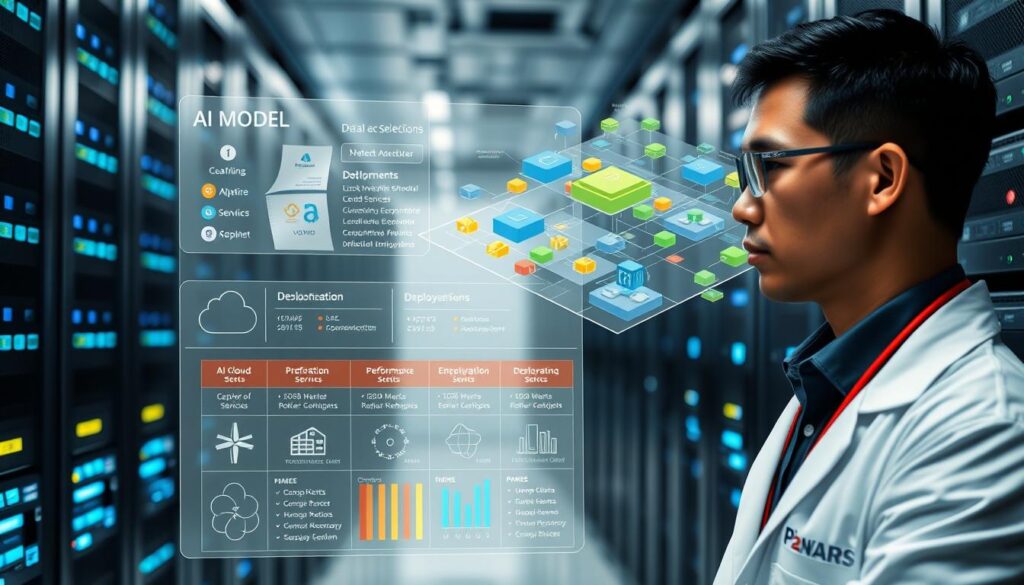Ever thought about what makes some AI deployments succeed while others fail? As businesses quickly adopt AI, the risks are higher than ever. Testing AI systems is key to making sure they work well in real life. By following the right steps before you deploy, you can boost your chances of success.
This article will show you how to make your AI deployment and integration meaningful and impactful. We’ll explore effective strategies for your journey.
Key Takeaways
- Understanding the importance of AI system testing is crucial for successful integration.
- Define clear goals and measurable objectives for effective deployment.
- Ensure data quality and accessibility to improve AI performance.
- Selecting the right AI model architecture is essential for achieving desired outcomes.
- Implementing pre-deployment best practices can mitigate risks associated with AI deployment.
- Incorporating stakeholder feedback is vital in refining AI systems before launch.
Understanding AI System Testing
AI system testing is key to checking if models work as expected before they’re used widely. It involves many tests to make sure AI systems do what they’re supposed to. Knowing about AI system testing helps us see why it’s so important in AI projects.
What is AI System Testing?
AI system testing is when we check how well machine learning models work. We look at things like how accurate and precise they are. Good testing makes sure models work well in real life, as they’re meant to.
The Importance of Testing Before Deployment
Testing is very important, more so as companies face more questions about their AI use. In places like Southeast Asia, showing that AI works well and fairly is crucial. Testing well helps build trust with customers and follows rules. It makes sure AI systems are reliable and safe, making testing essential before using them.
| Aspect | Description | Importance |
|---|---|---|
| Accuracy | Measures how often the system produces correct results. | High accuracy builds user trust and ensures reliability. |
| Precision | Evaluates the proportion of relevant instances among the retrieved instances. | High precision reduces false positives and enhances outcomes. |
| Recall | Focuses on the ability to identify all relevant instances. | High recall increases the likelihood of identifying true positives. |
Defining Your Goals for AI Integration
Setting clear goals for AI integration is key to aligning tech with business strategies. By defining specific AI goals, companies can set up a success framework. This involves setting measurable objectives that show what AI should achieve.
Establishing Measurable Objectives
Measurable objectives are key to checking if AI is working well. Companies might aim to cut down customer service times with AI chatbots or boost forecast accuracy by a certain percent. This makes it easier to make decisions and ensures everyone knows their part in reaching these goals.
Identifying Success Metrics
It’s vital to identify success metrics to measure AI’s impact. These metrics give a clear way to check if AI is doing its job. For example, tracking cost cuts or seeing how happy customers are after AI is used. These metrics help make better decisions for future AI plans.
| Objective | Description | Success Metrics |
|---|---|---|
| Reduce Response Time | Utilizing AI chatbots to manage customer inquiries | Average response time in minutes |
| Enhance Forecast Accuracy | Improving sales predictions through machine learning algorithms | Percentage increase in forecast accuracy |
| Improve Customer Satisfaction | Utilizing personalized recommendations through AI | Customer satisfaction survey scores |

Ensuring Data Quality and Accessibility
For AI systems to deliver valuable insights, ensuring data quality is essential. This means checking existing training data and following best practices for data preparation. The quality of data affects how accurate and reliable AI outputs are. In Southeast Asia, where competition is fierce, organizations must focus on robust training data evaluation to stay ahead.
Evaluating Training Data
Effective training data evaluation looks at data attributes like accuracy and completeness. Companies should check for biases that can skew results. This is crucial for maintaining trust in AI solutions. A thorough evaluation process includes several key points:
- Relevance: Make sure the training data matches the AI system’s purpose.
- Accuracy: Confirm the data accurately reflects real-world conditions.
- Completeness: Check if all necessary data points are included, avoiding gaps.
Data Preparation Best Practices
Implementing data preparation best practices can greatly improve AI model performance. This involves several steps:
- Data Cleaning: Fix inconsistencies and errors to avoid misleading results.
- Diversity: Use diverse data sources to ensure broad representation and avoid biases.
- Standardization: Use consistent formats and structures for easier integration during model training.
By following these guidelines, you can reduce the risk of poor data quality. This supports the development of reliable AI systems that can meet business challenges.
| Evaluation Criteria | Best Practices |
|---|---|
| Relevance | Align data with the AI system’s application |
| Accuracy | Regular verification of data integrity |
| Completeness | Gather comprehensive data sets |
| Data Cleaning | Correct errors to prevent misleading AI outputs |
| Diversity | Incorporate various data sources for comprehensive insights |
| Standardization | Consistent formatting for easy data integration |
Key Considerations for AI Model Selection
Choosing the right AI model is crucial for any project. It’s important to understand what your project needs. The right model architecture can make a big difference in how well it works.
Companies need to decide if they need supervised learning for tasks like classification or unsupervised learning for finding patterns. The model should fit the specific use case to work best.
Choosing the Right AI Model Architecture
There are many model architectures to choose from. Each has its strengths and challenges. Here are a few examples:
- Convolutional Neural Networks (CNNs): Great for image recognition and tasks that need to understand spatial hierarchies.
- Recurrent Neural Networks (RNNs): Best for data that comes in sequences, like text or time series.
- Transformer Models: Popular in natural language processing because they’re good at understanding context.
When choosing, think about what your project needs. Consider things like how easy it is to understand, how well it can grow, and how fast it can work.
Infrastructure Requirements for Deployment
The model you choose affects what you need for deployment. Setting it up right is key for smooth operation and growth. Here are some things to think about:
- Cloud Services: Using platforms like AWS or Google Cloud makes it easy to scale and be flexible.
- Hardware Specifications: Make sure your GPUs and CPUs can handle the model’s complexity.
- Data Storage Solutions: Choose options that allow for fast data access and processing.
Businesses in Southeast Asia can really benefit from cloud infrastructure. It helps them quickly meet changing needs. Matching your infrastructure to your model architecture boosts efficiency and performance.

Data Splitting Techniques for Robust Testing
Data splitting is key for testing AI models well. It divides data into parts to improve model performance and avoid mistakes. Training and validation sets are crucial for checking how well a model works on new data.
Good data division boosts performance and helps avoid overfitting and underfitting. This makes models more reliable and accurate.
Training, Validation, and Test Data Sets
Data is split into three main parts:
- Training Set: This part trains the AI model, teaching it to recognize patterns.
- Validation Set: It helps fine-tune the model and see how it does during training.
- Test Set: This is for checking the model’s performance after it’s fully trained. It’s vital for seeing how it will do in real life.
Avoiding Overfitting and Underfitting
Using data splitting wisely stops overfitting and underfitting. Overfitting happens when a model is too specific to the training data. Underfitting is when it’s too simple to catch the important trends.
Finding the right balance between training and validation sets is key. This balance helps create a model that works well in real situations.
Conducting Thorough Model Training and Validation
Model training and validation are key to a successful AI system. Organizations must make sure their models work well in real-world situations. They do this by tracking performance metrics to set success standards.
By watching these metrics, teams learn how well their models are doing. They can then make changes to improve performance.
Monitoring Performance Metrics
Monitoring performance metrics means checking important signs of a model’s success. Common signs include:
- Accuracy
- Precision
- Recall
- F1-Score
These signs help measure how well a model is doing. Regular checks keep models reliable and accurate.
Assessing Generalization Capabilities
It’s also important to check how well a model does on new data. Good ways to do this include:
- Using different test data from the training data
- Using cross-validation to make sure the model is strong
- Watching how the model performs to find areas to get better
By using these methods, teams can be sure their AI systems can handle different situations. This way, they can make their AI applications more practical and successful.

Testing Your AI Model Effectively
Testing AI models is key to knowing how well they work in real life. A good test plan uses special test datasets that the AI hasn’t seen before. This way, we can really see how good the model is and how it handles different situations.
Validating Performance with Test Datasets
Using test datasets helps us see how an AI model does in real-world tasks. By using a variety of data, we can check things like accuracy and how well it catches important details. This helps us know what the model is good at and where it needs work.
Evaluating Model Robustness with Edge Cases
Testing how an AI model does with unusual inputs is very important. These tests show us what the model can’t handle, helping us understand its limits. By testing it with tough inputs, we learn how well it can adapt and stay reliable.
By testing both how well an AI model performs and how robust it is, we make it more reliable. Companies in the Philippines and Southeast Asia find this helpful. It helps them deal with the challenges of different market needs.
Getting Stakeholder Feedback and Insights
Getting feedback from stakeholders and users is key to AI success. User testing lets teams see how AI works in real life. This helps improve and fine-tune the AI to meet user needs.
The Role of User Testing
User testing is crucial for understanding AI in real-world use. It helps developers get feedback on what works well and what needs work. Seeing how users interact with the system reveals insights that theory alone can’t show.
Incorporating Diverse Perspectives
In Southeast Asia, using diverse views is essential for AI success. Feedback from different backgrounds helps avoid bias and makes the AI useful for more people. By listening to many voices, teams create AI that truly meets user needs. Companies that do this find their AI systems connect better with their audience. For more on overcoming AI adoption hurdles, check out this resource.

Iterating and Improving Based on Test Results
Improving AI systems after testing is key. It makes sure the system works well and meets user needs. By looking at test results, companies can make changes to make the AI better.
Implementing Changes for Enhanced Performance
Adjusting AI models after testing is important. Companies should follow these steps:
- Find out where to improve based on feedback.
- Update models with new data to help them learn better.
- Test again to check if the changes worked.
These steps help improve models step by step. They encourage ongoing improvement and monitoring.
Documentation and Continuous Monitoring
Keeping detailed records is crucial. It helps track changes and understand how the AI system grows. By documenting every improvement, teams can see what makes the system better. Regular checks help companies stay on top of data changes and needs.
Conclusion
Testing AI systems is key to their success. Before fully deploying AI, it’s important to test it well. This includes using systematic methods, getting feedback from stakeholders, and making changes as needed.
This careful approach helps ensure AI systems work well and meet ethical standards. It’s crucial for their performance and reliability.
Choosing the right deployment strategies is also vital. Business leaders in the Philippines and Southeast Asia should focus on best practices. This helps create AI solutions that are efficient and can grow with the business.
By doing this, they can stay ahead in a changing market. It’s a way to strengthen their competitive edge.
After deploying AI, it’s important to keep checking how it works. This ongoing monitoring and evaluation are key to keeping AI applications effective. By following these steps, organizations can handle the challenges of AI technology well.
They can make sure their AI solutions stay useful and make a big impact.

